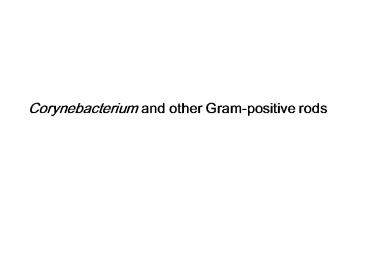Corynebacterium and other Gram-positive rods - PowerPoint PPT Presentation
1 / 10
Title:
Corynebacterium and other Gram-positive rods
Description:
Corynebacterium and other Gram-positive rods Corynebacterium : coryne, a club; bakterion, a small rod (a small, club-shaped rod) C. Diphtheriae : diphthera, leather ... – PowerPoint PPT presentation
Number of Views:87
Avg rating:3.0/5.0
Title: Corynebacterium and other Gram-positive rods
1
Corynebacterium and other Gram-positive rods
2
Corynebacterium
coryne, a club bakterion, a small rod (a small,
club-shaped rod)
C. Diphtheriae
diphthera, leather or skin (reference to the
leathery membrane that forms initially on the
pharynx)
Coryneform group Corynebacterium
and related genera
non-spore-forming,
non-acid-fast,
gram-positive rods with a high guanine plus
cytosine content.
metachromatic granules
catalase-positive
Ferment carbohydrates
Table. Characteristic properties of selected
Coryneform genera
Genus Catalase Fermentation/Oxidation Motility Cell Wall Cell Wall Gram Stain
Mycolic Acids Diamino Acid
Corynebacterium Ferm/Oxid - meso-DAP Club-shaped rods
Arcanobacterium - Ferm - - Lysine Irregularly shaped rods
Brevibacterium - Oxid - - meso-DAP Short coccobacilli
Oerskovia - Ferm Variable - Lysine Long branching rods
Turicella - Oxid - - meso-DAP Long rods
3
Corynebacterium species associated with human
disease
Organism Diseases
C. diphtheriae Diphtheria (respiratory, cutaneous) pharyngitis and endocarditis (nontoxigenic strains)
C. jeikeium (group JK) Septicemia, endocarditis, wound infections, foreign body (catheter, shunt, prosthesis) infections
C. urealyticum (group D2) Urinary tract infections (including pyelonephritis and alkaline-encrusted cystitis), septicemia, endocarditis, wound infections
C. amycolatum Wound infections, foreign body infections, septicemia, urinary tract infections, respiratory tract infections
C. macginleyi Eye infections
C. minutissimum Wound infections, respiratory tract infections
C. pseudodiphtheriticum Respiratory tract infections, endocarditis
C. pseudotuberculosis Lymphadenitis, ulcerative lymphangitis, abscess formation
C. riegelii Genitourinary tract infections (females)
C. striatum Wound infections, respiratory tract infections, foreign body infections
C. ulcerans Respiratory diphtheria
4
Corynebacterium diphtheriae
PHYSIOLOGY AND STRUCTURE
- Pleomorphic rod (0.3 to 0.8 1.0 to 8.0 µm)
- Metachromatic granules rods stained with
methylne blue - 1- to 3-mm colonies are observed on blood agar
medium
PATHOGENESIS AND IMMUNITY
- Classic model of bacterial virulence.
- Toxicity in diphtheria exotoxin secreted by
the bacteria at the focus of infection - The organism does not need to enter the blood to
produce the systemic signs of disease
Diphtheria toxin Two processing steps (1)
proteolytic cleavage of the leader sequence from
the tox protein during secretion from the
bacterial cell and (2) cleavage of the toxin
molecule into two polypeptides (A and B) that
remain attached by a disulfide bond. This
58,300-Da protein is an example of the classic
A-B exotoxin.
- - B subunit receptor-binding region,
translocation region - - receptor heparin-binding epidermal
growth factor - - A subunit catalytic region
- Toxin entry the toxin becomes attached to the
host cells, facilitating the movement of the
catalytic region into the cytosol. - cytotoxicity The A subunit terminates host
cell protein synthesis by inactivating elongation
factor 2 (EF-2) ADP-ribosylation - Toxin synthesis regulation chromosomally
encoded element, diphtheria toxin repressor
(DTxR). activated in the presence of high-iron
concentrations
5
(No Transcript)
6
EPIDEMIOLOGY
- Diphtheria found worldwide
- - Respiratory droplets or skin contact transmit
- - Humans are the only known reservoir for this
organism - C. diphtheriae maintenance asymptomatic
carriage in the oropharynx or on the skin of
immune people (after either exposure to C.
diphtheriae or immunization) - - uncommon in the United States as the result of
an active immunization program
CLINICAL DISEASES
- The clinical presentation of diphtheria
- the site of infection,
- the immune status of the patient,
- the virulence of the organism.
BOX 27-3. Corynebacterium diphtheriae Clinical Diseases
Respiratory diphtheria Sudden onset with exudative pharyngitis, sore throat, low-grade fever, and malaise a thick pseudomembrane develops over the pharynx in critically ill patients, breathing obstruction, cardiac arrhythmia, coma, and death can develop
Cutaneous diphtheria A papule can develop on the skin that progresses to a nonhealing ulcer systemic signs can develop
7
This child has diphtheria resulting in a thick
gray coating over back of throat. This coating
can eventually expand down through airway and,
if not treated, the child could die from
suffocation CDC
8
LABORATORY DIAGNOSIS
The initial treatment of a patient with
diphtheria is instituted on the basis of the
clinical diagnosis, not laboratory results,
because definitive results are not available for
at least a week
Microscopy
- Metachromatic granules stained with
methylene blue - appearance is not specific to
C. diphtheriae, and interpretation of the smear
requires technical expertise
Culture
Specimens for the recovery nasopharynx and the
throat - enriched blood agar plate and a
medium developed specifically (e.g.,
cysteine-tellurite agar, serum tellurite agar).
Tellurite, Löffler's medium
Toxigenicity Testing
Test for the production of exotoxin in
vitro immunodiffusion assay (Elek test), a
tissue culture neutralization assay using
specific antitoxin, in vivo neutralization
assay using guinea pigs injected subcutaneously
with the isolate from the patient.
9
(No Transcript)
10
TREATMENT, PREVENTION, AND CONTROL
- - Diphtheria antitoxin neutralize the exotoxin
before it is bound by the host cell. - Antibiotic therapy penicillin or erythromycin
is also used to eliminate C. diphtheriae and
terminate toxin production - After the patient has recovered, immunization
with toxoid is required
Prevention children - five injections of
diphtheria with pertussis and tetanus antigens
(DPT vaccine) at ages 2, 4, 6, 15 to 18 months,
and at 4 to 6 years.
- Penicillin, erythromycin































